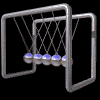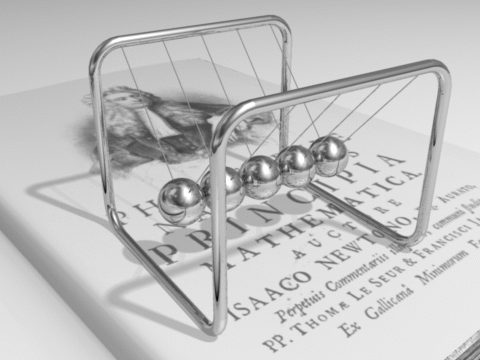 Experiment & Rationalism
Experiment & Rationalism
Paz, Octavio
Isaac Newton, Member & President of the Royal Society. The emergence of experimentation in Natural Philosophy based on mathematics. (1605–1730)
The struggle over adequate, reliable, & verifiable descriptions of faith, planetary motion, tides, gravity, materials, & light.
Carl Sagan's Cosmos, depicts Newton as a revolutionary physical scientist; he was also an alchemist, astronomer, & Unitarian. Newton demonstrated by use of a triangular glass that day light (white or clear light) is a composite of refracted colors. His use of a prism as an instrument of discovery is associated with heuristics, the study of how we find out about things.
"He often declared his conviction as to the older of these practicalities, as he wrote to Bentley about his satisfaction in having advanced the cause of true religion by his scientific discoveries.
"my treatise (the Principia) about our system."
"I had an eye on such principles as might work with considering Men for the belief of a Deity."
The cosmos, Newton wrote in 1713, "could not have arisen without the design and dominion of an intelligent and powerful being."
I. Bernard Cohen, The Newtonian Revolution, p. 5
his rivalry with Robert Hooke.

life | science | faith | ethos | Royal Society | Fire-Alchemy | Revolution | Mechanistic worldview
By the older of these practicalities, Cohen states that: "Science was traditionally practical in serving the cause of religion; but a revolutionary feature of the new science was the additional pragmatic goal of bettering everyday life here and now through applied science,"
I. Bernard Cohen, The Newtonian Revolution, p. 5.
Isaac Newton, (1642 -1727) was born the poor son of a illiterate, yeoman farmer 12/25/1642, in Lincolnshire.
premature infant
mechanically inclined child; his father died when he was an infant
home was at Woolsthorpe
1661 entered Trinity College in Cambridge
1665 plague forced him home for safety
- discovered bright white light is a composite of refracted colors
- formulated the law of universal gravitational attraction (inverse square law)
- created fluxions as the foundation of differential Calculus
1667 returned when Cambridge reopened in the Spring for his Masters degree
1669 Lucasian Chair of Mathematics relinquished by Barrow favoring Newton
1672 elected to the Royal Society for his optical experiments
1675 successfully prepared a ‘philosophical mercury’ following alchemical texts
1684 he describes the planetary orbits for Sir Edmund Halley as an ellipse!
1687 his notes and proofs became The Mathematical Principles of Natural Philosophy
1699 became Master of the Mint.
1703 President of the Royal Society
1704 published the Opticks [1706, 1721, 1730 editions]
1705 he was knighted

life | science | faith | ethos | Royal Society | Fire-Alchemy | Revolution | Mechanistic worldview
Sir Isaac Newton, Master of the Mint, experimental physicist, alchemist, mathematician, & scriptural expert.
Newton's principle interests were:
Galileo and Kepler on the Laws of planetary motion
In the Plague Year he retreated from Cambridge to his home at Woolsthorpe (1666)
Annus mirabilis
- Gravity (inverse square law)
- Calculus (infinitessimal)
- Light is a composite of colors – corpuscles & the spectrum
- Refracting telescopes
He published:
1687 Principia Mathematica
1701 Opticks
Robert Hooke and W. G. Leibniz both were Newton's life-long nemeses.

life | science | faith | ethos | Royal Society | Fire-Alchemy | Revolution | Mechanistic worldview
Newton wrote more about Alchemy and mostly about holy scriptures and the Bible than he ever did about physics and mathematics. Despite the requirement to to teach at Cambridge that he must accept the Anglican interpretations of theology, he believed that:
Christ is not the equal of God the Farther,
- he rejected the Trinity
- and accepted Unitarianism
He used the scriptures to determine the second coming of Christ mathematically to be between 2045 and 2060.
John Maynard Lord Keynes wrote of Newton:
“He regarded the universe as a cryptogram set by the Almighty....”
piety and righteousness were two preeminent expressions of value for Newton’s moral imagination.
Alchemy
Greek myths (Ovid’s metamorphosis) are actually alchemical formulas:
Hephaestus finds Aphrodite and Ares together, binds them together in a blue web mesh, and displays them to the gods.
Really this code stands for iron (Ares) and copper (Aphrodite) fused into a blue alloy.
| Alchemical descriptor | element and (DEITY) | planet |
|---|---|---|
| Star regulus | iron ( Ares ) |
Mars |
| Green Dragon | copper ( Aphrodite ) |
Venus |
57 of 121 original alchemical books recovered from the Newton collection.
the “Oak”, the “Green Lion”, and the “Star” -- Alchemical motifs are mentioned in Newton’s laboratory notes.
(Dobbs, Newton’s Alchemy, p. 16)*
“Newton was a remarkably conscientious note taker and transcriber,”
(21)
Alchemy (rediscovered Greek, Arabic, Hindi & Chinese in 1200s) spiritual alchemy in the 1620s-30s became associated with general reform of society because it sought eternal truths in their material manifestation such as the "elixir of life," or the capacity to transmute one substance into another.
Strange as that concept may seem, the transmutation of matter was based on the observation that mercury a silvery, liquid can emerge from cinnabar a dry, red powder, when the cinnabar is heated. Mercury was used to separate gold from the calcite in which it was embedded.

life | science | faith | ethos | Royal Society | Fire-Alchemy | Revolution | Mechanistic worldview
Ideas in the scientific revolution.
inverse square law
16th, Sixteenth & 17th, Seventeenth centuries:
Reformation & heresy (1517) of Luther & Calvin promote Protestantism
Newton was one among dozens of empirical thinkers who was fascinated by scripture, alchemy, nature and experimental laboratory work.
He performed experiments following alchemical texts to establish a new certainty about knowledge of nature and the elements that the Ancients had known but, he felt, had been lost to he and his contemporaries.
House of Anhalt (German Protestants) had promoted Alchemy and sponsored publications.

life | science | faith | ethos | Royal Society | Fire-Alchemy | Revolution | Mechanistic worldview
Newton's aftermath: Was he the Midwife of the Mechanistic Universe?
mechanism (clocks & watches, water wheels, steam engines and pumps)
reform: anticlericalism, rational laws, upper classes demanded power from nobility.
German mysticism, 16th cent. (Paracelsus); search for universal harmonies & sympathies.
Inquisition (Spanish & Italian) Dominican search for heretics.
Counter-Reformation (1565) Catholic & Jesuit responses to reconvert the lost faithful.
William Blake's sketch of Newton deciphering the geometry of the universe.
Dominant strains in intellectual history in 1600s-1800s:
Cartesian Rationalism, analytical geometry, materialism & methodology [Rene Descartes (March 31, 1596 – February 11, 1650) ].
Rosicrucian (reform and enlightenment is attainable in this world) [Robert Fludd, (1574, Bearsted, Kent – September 8, 1637, London)] A belief, of a secret society (of the rose cross) that a heaven on earth is possible through strict observance of sacred rituals and the capacity to drive out spirits from bodies contaminated by evil.
Their focus on rebirth and resurrection in man has its corresponding rationality in the reform of society. Faith in a New Jerusalem to be created in Europe by faithful believers in the word of God and revelation. The order traces to Germany though it was revive in the 1604-1614 period. The brethren of the "Rose Cross" published works that proclaimed "the social need to establish a traditional institution to guide humanity towards spiritual truth and personal enlightenment."
For more details see The Rosicrucian Archive site.
Neo-Platonism the importance of mathematics, numbers and underlying orderliness of reality based on formulas that reveal hidden likenesses, such as Boyle's law, gravity and pendulums.
§§§
-------------
sources:* Betty J. T. Dobbs, The Foundations of Newton’s Alchemy: or the Hunting of the Green Lion. Cambridge: Cambridge University Press, 1975.
Newton's Biographer is Gale Christianson
NOVA: Tuesday, November 15, 2005, 8PM
Founding of the Royal Society:
"Dr. John Wilkins convened a meeting of the virtuosi (28 November 1660) ...at which he proposed to found 'a college for the promoting of Physico-Mathematical Experimental Learning'."
13 August 1662, King Charles II founded "The Royal Society for the improvement of natural knowledge by experiment"

life | science | faith | ethos | Royal Society | Fire-Alchemy | Revolution | Mechanistic worldview
Science Index | Site Analysis | Population Index | Global Warming Index | Nature Index | Brief






